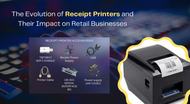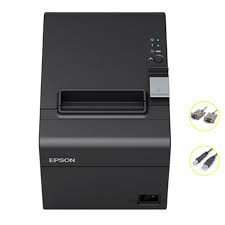The Evolution of Receipt Printers and Their Impact on Retail Businesses
Efficient transactional processes form the backbone of successful retail operations. Streamlining these processes is crucial for ensuring a seamless customer experience from product selection to payment completion. The swift and accurate execution of transactions not only expedites customer interactions but also contributes significantly to overall satisfaction and loyalty. Reduced waiting times at the point of sale create a positive atmosphere, enhancing the overall perception of the retail space. In the ever-evolving retail landscape, optimised transactional processes empower businesses to stay agile and competitive, meeting the fast-paced demands of the market. In essence, the efficiency of these processes is not merely a functional aspect but a pivotal factor that shapes the success and sustainability of retail enterprises.
In this blog post, we'll explore the evolution of receipt printers and their impact on the retail sector.
Let’s start by discussing-
What are Receipt Printers?
Receipt printers are essential devices in the retail and business sectors designed to generate printed records of transactions. These devices play a crucial role in providing customers with tangible proof of their purchases. Typically used at points of sale (POS), receipt printers produce a physical copy of a sales transaction, detailing items purchased, prices, and other relevant information. There are various types of receipt printers available, ranging from traditional dot matrix printers to modern thermal printers. Dot matrix printers use tiny pins to create characters, while thermal printers utilise heat to produce images on specially coated paper. The evolution of receipt printers has seen the emergence of portable options, allowing businesses to issue receipts on the go, and enhancing customer convenience.
Evolution of Receipt Printers
The evolution of receipt printers has been a fascinating journey that mirrors the technological advancements in the retail and business sectors. In the early days, handwritten receipts were the norm, marking the inception of transaction documentation. As technology progressed, mechanical receipt printers emerged, automating the process and significantly improving transaction speed.
The shift from mechanical to electronic receipt printers gained momentum in the 1980s, with the introduction of dot matrix printers. These devices offered faster printing speeds and improved print quality, marking a notable improvement in efficiency. The 1990s witnessed a pivotal transition to thermal printing technology. Unlike dot matrix printers, thermal printers used heat to produce images, resulting in faster, quieter, and more reliable printing. This shift not only enhanced the efficiency of point-of-sale (POS) systems but also contributed to a reduction in operating costs for businesses.
Portable receipt printers emerged as a game-changer in the 2000s, allowing businesses to generate receipts on the spot. These compact and mobile devices facilitated transactions at various locations, such as events, pop-up shops, and outdoor markets, providing a new level of convenience and flexibility.
In recent years, the market has witnessed a diverse range of receipt printers catering to specific business needs. Whether it's a compact portable receipt printers for on-the-go transactions or a high-speed POS receipt printer for bustling retail environments, businesses now have a plethora of options to choose from.
The evolution of receipt printers continues to reflect the ever-changing landscape of retail technology. As businesses embrace digital transformation, receipt printers remain a fundamental element in ensuring smooth and efficient transaction processes, leaving a tangible mark on the history of retail innovation.
Types of POS Receipt Printers
Receipt printers come in various types, each with its own set of features and advantages, catering to diverse business needs.
Here's an overview of the different types of receipt printers:
Dot Matrix Receipt Printers
- Description: Dot matrix printers use a matrix of tiny pins to impact an inked ribbon, creating characters on paper.
- Advantages: Cost-effective, capable of producing carbon copies, and durable.
Thermal Receipt Printers
- Description: These printers use heat to produce images on specially coated paper without the need for ink or ribbons.
- Advantages: Fast printing speeds, high print quality, quiet operation, and low maintenance costs.
Inkjet Receipt Printers
- Description: Similar to traditional document inkjet printers, they use liquid ink to produce high-quality prints.
- Advantages: Excellent print quality, capability to print colour receipts, and versatility.
Portable Receipt Printers
- Description: Compact and lightweight printers designed for on-the-go use, often employed in mobile point-of-sale (mPOS) systems.
- Advantages: Portability, wireless connectivity options, and ideal for businesses that require mobility.
Kiosk Receipt Printers
- Description: Specifically designed for self-service kiosks, these printers are rugged and capable of handling high transaction volumes.
- Advantages: Durable, able to withstand harsh environments, and suitable for unattended operation.
POS Receipt Printers
- Description: Tailored for use at point-of-sale terminals, these printers are optimised for high-speed, high-volume printing.
- Advantages: Efficient, reliable, and often designed to integrate seamlessly with POS systems.
Impact of Receipt Printers in Retail Businesses
The impact of receipt printers on retail businesses is profound, extending beyond mere transaction documentation.
- Customer Satisfaction: Receipt printers contribute significantly to customer satisfaction by providing tangible proof of transactions. Customers appreciate having a physical record of their purchases, returns, or exchanges, adding a layer of trust and accountability to the retail experience.
- Transaction Accuracy: The automated nature of receipt printers minimises the risk of errors in transaction documentation. This accuracy is crucial for both customers and businesses, ensuring that the details of each sale are recorded correctly, reducing disputes and enhancing the overall reliability of the retail process.
- Efficiency at Checkout: In high-traffic retail environments, the efficiency of the checkout process is paramount. Receipt printers, especially those integrated with point-of-sale (POS) systems, facilitate quick and seamless transactions. Fast and reliable printing ensures that customers can complete their purchases efficiently, reducing waiting times and improving the overall shopping experience.
- Financial Record Keeping: Receipts generated by these printers serve as essential financial records for businesses. They provide a comprehensive overview of daily transactions, aiding in accounting, tax compliance, and financial analysis. This organised documentation is crucial for maintaining financial transparency and meeting regulatory requirements.
- Inventory Management: In scenarios where receipts detail specific items purchased, businesses can leverage this information for effective inventory management. Analysing sales data from receipts helps businesses understand product popularity, manage stock levels, and make informed decisions regarding product restocking and assortment.
- Customer Engagement: Some modern receipt printers are equipped with capabilities beyond basic transaction printing. For instance, they can include promotional messages, discount coupons, or survey requests on receipts. This serves as a valuable tool for customer engagement, encouraging repeat business and soliciting feedback.
- Adaptability to Mobile Commerce: The rise of mobile commerce and point-of-sale solutions has increased the importance of portable receipt printers. These devices empower businesses to conduct transactions anywhere within a store or at off-site events. Mobile receipt printing enhances flexibility and meets the demands of modern, on-the-go retail practices.
- Brand Image and Professionalism: Well-printed, clear, and professional-looking receipts contribute to a positive brand image. Customers perceive businesses that invest in reliable and modern receipt printing technology as more professional and trustworthy, enhancing the overall reputation of the brand.
The evolution of receipt printers reflects the broader technological advancements in the retail sector. From manual processes to electronic systems, and now to portable and high-speed thermal printers, the journey has been remarkable. Businesses, especially in Australia, can now choose from a variety of receipt printers for sale, ensuring that they meet the unique needs of their operations. As retail continues to evolve, receipt printers will likely remain a cornerstone of seamless and efficient customer transactions.
That said, if you are looking to buy premium quality receipt printers online at the best prices in Australia, POS Sales Australia is your one-stop destination. We have all the premium brands of POS receipt printers available at the best prices. Browse through our selection of receipt printers and shop for the perfect device to meet your business needs today!
Contact us for any inquiries or speak directly to our POS expert @ 1300 026 062



